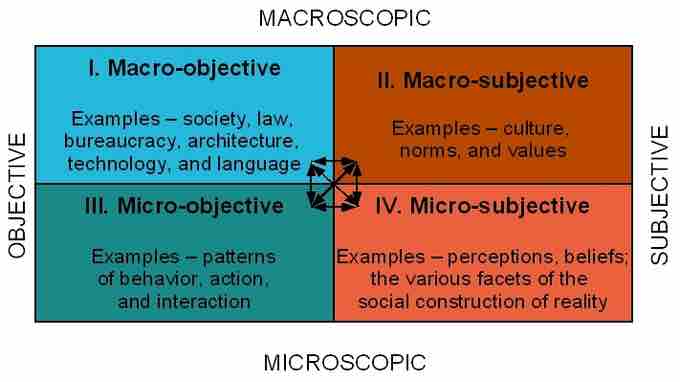Sociological approaches are differentiated by the level of analysis. Macrosociology involves the study of widespread social processes . Microsociology involves the study of people at a more interpersonal level, as in face-to-face interactions.
The macro-level study of widespread social processes has been the more dominant approach, and has been practiced since sociology's origins in the founding work of figures like Emile Durkheim. Durkheim, for example, studied the large-scale shift from homogenous traditional societies to industrialized societies, where each individual played a highly specialized role. The tendency toward macrosociology is evident in the kinds of questions that early sociologists asked: What holds societies together? How are norms (and deviance) established and handled by societies? What factors lead to social change, and what are the results of this change? Macrosociologists focus on society as a whole, as something that is prior to, and greater than, the sum of individual people.
Studying social life on the micro-level is a more recent development (in the early and mid-twentieth century) in the history of the field, and was pioneered by proponents of the symbolic interactionism perspective, namely George Herbert Mead, Herbert Blumer, and Erving Goffmann. Mead was a pragmatist and behaviorist, which means several things.
- To pragmatists, true reality does not exist "out there" in the real world. It "is actively created as we act in and toward the world. "
- People remember and base their knowledge of the world on what has been useful to them, and are likely to alter what no longer "works. "
- People define the social and physical "objects" they encounter in the world according to their use for them.
- If we want to understand actors, we must base that understanding on what people actually do.
Blumer built on Mead's work. He believed that individuals create their own social reality through collective and individual action, and that the creation of social reality is a continuous process. Goffman elaborated on both Mead and Blumer by formulating the dramaturgical approach . He saw a connection between the acts people put on in their daily life and theatrical performances. In social interaction, like in theatrical performance, there is a front region where the "actors" (individuals) are on stage in front of the audience. This is where the positive aspect of the idea of self and desired impressions is highlighted. There is a back region, or stage, that can also be considered a hidden or private place where individuals can be themselves and step out of their role or identity in society. Face-to-face interactions are, thus, a stage where people perform roles and practice impression management (i.e. "saving face"). Other scholars have since developed new research questions and methods for studying micro-level social processes.
Micro- and macro-level studies each have their own benefits and drawbacks. Macrosociology allows observation of large-scale patterns and trends, but runs the risk of seeing these trends as abstract entities that exist outside of the individuals who enact them on the ground. Microsociology allows for this on-the-ground analysis, but can fail to consider the larger forces that influence individual behavior.

A Taxonomy of Sociological Analysis
Sociological analysis can take place at the macro or micro level, and can be subjective or objective.